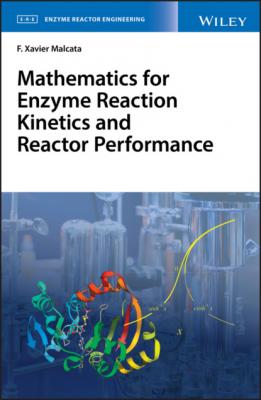Mathematics for Enzyme Reaction Kinetics and Reactor Performance. F. Xavier Malcata
Читать онлайн.| Название | Mathematics for Enzyme Reaction Kinetics and Reactor Performance |
|---|---|
| Автор произведения | F. Xavier Malcata |
| Жанр | Химия |
| Серия | |
| Издательство | Химия |
| Год выпуска | 0 |
| isbn | 9781119490333 |
then it becomes clear that Eq. (2.236) will be valid for n + 1 if it is already valid for n; further validity of Eq. (2.236), for the trivial case of n = 0 as per Eqs. (2.249) and (2.250), then suffices to support validity of Eq. (2.236) in general, as per finite induction.
Equation (2.236) obviously applies when a difference rather than a sum is at stake – as already perceived with Eq. (2.238); just replace y by −y, and then apply Newton’s binomial formula to x and −y, according to
(2.263)
– where the minus sign is often taken out to yield
(2.264)
at the expense of (−1)k = (−1)−k .
As mentioned previously, Newton generalized the binomial theorem so as to encompass real exponents other than nonnegative integers – and eventually came forward with
where the generalized (binomial) coefficient should then read
(2.266)
en lieu of Eq. (2.240); Pochhammer’s symbol, ((r))k, stands here for a falling factorial, i.e.
with ((r))0 set equal to unity by convention – which, if r > k − 1 is an integer, may be reformulated to
(2.268)
following multiplication and division by (r−k)(r − (k + 1))⋯1. For instance, Eqs. (2.265)–(2.267) give rise to
where k → ∞∞ because r = 1/2; Eq. (2.269) degenerates to
(2.270)
or else
(2.271)
following straightforward algebraic manipulation and condensation afterward. If r is instead set equal to −1 and y set equal to 1, then Eq. (2.265) gives rise to
(2.272)
– where algebraic rearrangement supports dramatic simplification to
(2.273)
the right‐hand side is but a geometric series of first term equal to 1 and ratio between consecutive terms equal to −x, so one may retrieve Eq. (2.93) to write
(2.274)
since
after replacement of x in Eq. (2.265) by its negative, y by 1, and exponent r by a general negative number −z; Eq. (2.275) eventually yields
If a rising factorial, (z)k, is defined as
(2.277)
with evolution opposite to that entailed by Eq. (2.267), one may condense Eq. (2.276) to
(2.278)
In the case of a trinomial, its square may be calculated via
(2.279)
in agreement with Eq. (2.237) applied to x1 + x2 and x3, rather than x and y; a second application of said formula to (x1 + x2)2 generates
(2.280)
that may be rearranged to read
upon elimination of parenthesis. The above reasoning may be applied to any (integer) exponent n, and to any number m of terms of polynomial x1
